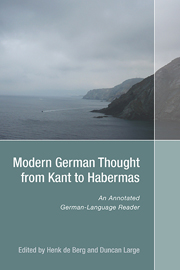Book contents
- Frontmatter
- Contents
- Acknowledgments
- Introduction: German Thought since Kant
- 1 Immanuel Kant (1724–1804)
- 2 Georg Wilhelm Friedrich Hegel (1770–1831)
- 3 Ludwig Feuerbach (1804–72)
- 4 Arthur Schopenhauer (1788–1860)
- 5 Karl Marx (1818–83)
- 6 Friedrich Nietzsche (1844–1900)
- 7 Sigmund Freud (1856–1939)
- 8 Martin Heidegger (1889–1976)
- 9 Walter Benjamin (1892–1940)
- 10 Georg Lukács (1885–1971)
- 11 Max Horkheimer (1895–1973) and Theodor W. Adorno (1903–69)
- 12 Jürgen Habermas (b. 1929)
- Index
- About the Editors
9 - Walter Benjamin (1892–1940)
Published online by Cambridge University Press: 05 September 2014
- Frontmatter
- Contents
- Acknowledgments
- Introduction: German Thought since Kant
- 1 Immanuel Kant (1724–1804)
- 2 Georg Wilhelm Friedrich Hegel (1770–1831)
- 3 Ludwig Feuerbach (1804–72)
- 4 Arthur Schopenhauer (1788–1860)
- 5 Karl Marx (1818–83)
- 6 Friedrich Nietzsche (1844–1900)
- 7 Sigmund Freud (1856–1939)
- 8 Martin Heidegger (1889–1976)
- 9 Walter Benjamin (1892–1940)
- 10 Georg Lukács (1885–1971)
- 11 Max Horkheimer (1895–1973) and Theodor W. Adorno (1903–69)
- 12 Jürgen Habermas (b. 1929)
- Index
- About the Editors
Summary
Life and Work
Walter Bendix Schönflies Benjamin was born into a wealthy Jewish family in Berlin in 1892. His childhood, which he would later evoke in the memoir Berliner Kindheit um neunzehnhundert, was culturally refined and protected, with servants, French nannies, elegant soirées, and expensive holidays. (As an adult, Benjamin admitted he could not even make his own coffee.) After several years of private tutoring, he was forced into the straitjacket of a Prussian Gymnasium. Only an extended stay, made for health reasons, at the progressive Thuringian boarding school Haubinda offered a temporary respite from an educational regime that Benjamin experienced as tyrannical and collectivist. At Haubinda, the precocious adolescent came under the influence of the school reformer Gustav Wyneken (1865–1964), who propagated an elitist and idealistic concept of social renewal — a transformation of the oppressive and philistine Wilhelmine Empire through a cultural revolution based on the vitalism and purity of youth.
From 1912 to 1917, Benjamin studied philosophy at the universities of Freiburg, Berlin, and Munich. Initially, most of his energy was devoted not to studying but to furthering Wyneken's cause through organizational activities and publications. However, as the movement became increasingly politicized, Benjamin grew skeptical about its potential to bring about genuine change. Wyneken's blind enthusiasm about the outbreak of the First World War, a conflict his former pupil considered pointless and deeply tragic, was the final straw. The young student now gravitated towards a religiously inspired philosophy of history that, in a rather opaque manner, viewed the present as a kind of prefiguration of a Messianic end-time. Central to this development was his friendship with the Jewish-German philosopher and historian Gershom Scholem (1897–1982), who had a strong interest in Jewish mysticism.
- Type
- Chapter
- Information
- Modern German Thought from Kant to HabermasAn Annotated German-Language Reader, pp. 239 - 280Publisher: Boydell & BrewerPrint publication year: 2012



